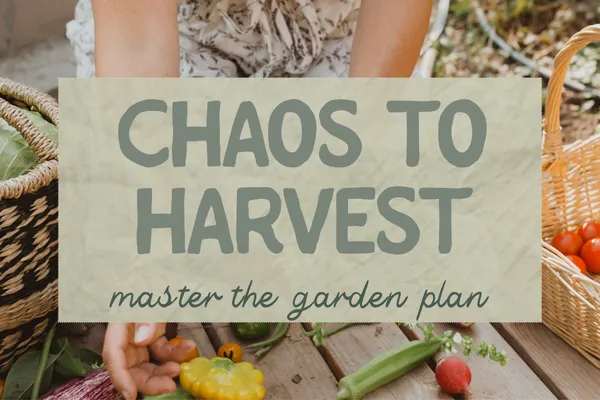
From Chaos to Harvest: Mastering Your Vegetable Garden Plan
Last summer, Sarah had big dreams for her garden. She was excited to grow everything she loved—tomatoes, zucchini, peppers, lettuce, you name it.
But by mid-July, her garden was a jungle of overgrown zucchini, her carrots barely sprouted, and her tomato seedlings were still waiting for their turn in the soil. By August, she felt defeated and overwhelmed, vowing that next year would be different.
Sound familiar? You’re not alone. Planning a vegetable garden can feel like an overwhelming puzzle. What should you grow? How much space will you need? When should you plant each crop? The good news is that with a little forethought and a few simple tools, you can turn garden chaos into a thriving, productive oasis. Let’s walk through the key steps to create a vegetable garden plan that works for you.

Key Takeaways
Reflect on last year’s garden successes and challenges.
Map out a thoughtful garden layout, including plant sizes and companion planting.
Build a planting calendar based on frost dates and crop maturity.
Learn how to stagger and succession plant for continuous harvests.

Start with Goals: What Do You Want to Grow and Why?
Before you sketch a single line on your garden map, take a moment to reflect on your goals. Think about what you want to grow and why.
Reflect on Last Year
What worked well in your garden last year? Maybe your kale thrived while your peppers struggled. What didn’t work? Did you plant too much of one thing and not enough of another? Use these reflections to guide your decisions.
Set Priorities
Focus on Favorites: Start with the veggies and herbs your family actually loves to eat. If fresh salsa is your jam, prioritize tomatoes, peppers, and cilantro. If salads are a staple, make room for lettuce and spinach.
Consider Challenges: If pests devoured your zucchini last year, consider planting a different variety or companion plants to deter them.
Make a List
Create a “must-grow” list, organized by cool-season and warm-season crops. Cool-season crops (like spinach, kale, and radishes) thrive in early spring and fall, while warm-season crops (like tomatoes and cucumbers) love summer heat.
💡 Pro Tip: The key to a successful garden isn’t planting everything—it’s planting the right things for you.

Map It Out: Designing Your Garden Layout
Once you know what you want to grow, it’s time to map out your space. A thoughtful layout ensures every plant has the room and conditions it needs to thrive.
Use Your Space Wisely
Consider Plant Sizes: Tall plants like tomatoes and sunflowers should go at the back or north side of the garden to avoid shading smaller crops. Compact plants like lettuce can fill gaps.
Think Vertical: Use trellises for beans, cucumbers, and peas to save space and increase yields.
Group by Season: Keep cool-season crops together for easy succession planting when they’re replaced by warm-season crops.
Companion Planting
Pair plants that help each other thrive. Mix different botanical families, just like in nature, along with a variety of flowers to attract beneficial insects.
Sketch Your Layout
On paper or with a garden planning app, draw your garden beds and assign space for each crop. Label areas for early crops and those that will take over later in the season, like squash.
💡 Pro Tip: Think of your garden like a 4-dimensional puzzle—every plant has its perfect spot in both space and time.


Timing is Everything: Build a Planting Calendar
When you plant your seeds or transplants can make all the difference. Timing your plantings based on frost dates and crop maturity ensures a steady harvest.
Work Backward from Average Last Frost Window
Yes, window, not date. For Eagle and Gypsum, the frost window is late May to early June; for higher elevations, it’s mid to late June. Use this to guide seed starting and planting.
Succession Planting
Plan for multiple harvests by staggering plantings every 2–3 weeks. For instance, plant lettuce in intervals for continuous fresh greens.
Track It All
Keep a simple calendar to track key dates for seed starting, transplanting, and succession planting. This keeps you organized and prevents missed opportunities.
💡 Pro Tip: Don’t try to master everything at once. Focus on a few skills each year.

Wrap it up and next steps: join us to plan with confidence!
With clear goals, a thoughtful layout, and a smart planting calendar, you can create a garden that’s productive, manageable, and tailored to your needs. Whether you’re working with a small backyard or a sprawling plot, every seed you plant is a step toward a thriving garden.
Want personalized help planning your garden? Join our Garden Planning Workshop to create your map, set your planting calendar, and design a garden that works for you. Reserve your spot today at www.shop.wigglewormgardens.com/events!


Copyright 2023-2025 Wiggle Worm Gardens
Visit Our Sister companies
Fourth Street Farm: edible landscaping and raised bed garden design and installation
Ground Up: Soil health and compost tea

